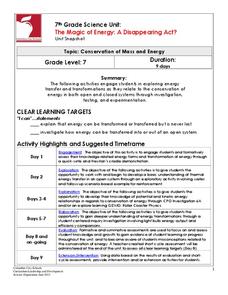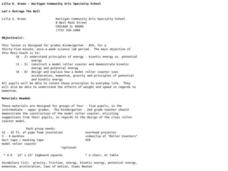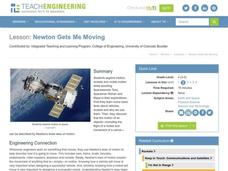Curated OER
Some Famous Unit Conversion Errors!
For this unit conversion worksheet, students are given 3 stories about situations where errors in the conversion of units caused dramatic problems in science. For each situation, students practice converting units to solve the errors.
Curated OER
Discovery Science Library: The Basics Physical Science
Students examine friction and gravity. affect four sports. In this scientific discovery lesson, students examine how friction and gravity affect sports. They discuss, write, and illustrate the effect of different forces on various...
Curated OER
Magnetism
A wonderfully rich presentation teaches about magnets and magnetism. Each slide is packed with interesting information on the discovery, history, physics, and uses for magnets. Good photographs, and an emphasis on vocabulary are part of...
Curated OER
A County Fair Can Lead to an Exploration of Math, Science, and Literature
A county fair can provide an educational experience for students.
Tech Museum of Innovation
Energy at Play
Get the ball rolling and challenge your class to figure out how to make a ball move. The instruction segment is between two STEM activities devoted to doing just that. The first is simple and involves making a ball move from some...
Teach Engineering
Energy Forms and States Demonstrations
Does a tennis ball have energy? What about a bowling ball? Demonstrate concepts of different forms of energy forms and states with a variety of objects. Using the equations for potential and kinetic energy,...
DiscoverE
Marble Run
It's time to slow your roll! Can your class create a track that allows a marble to roll as slowly as possible? Teams of science scholars collaborate to design, build, and test their tubes while learning about gravity and friction.
Curated OER
Children's Literature Across the Curriculum Ideas-The Gadget War
Students read The Gadget War by Betsy Duffey. They complete a variety of cross-curricular activities surrounding inventors and inventions. Included are reading, art, math, science, writing, social studies, and library connections.
Curated OER
Acceleration
The mechanics of rollercoasters, and the acceleration and velocities reached with the different kinds, are outlined in this presentation. Although short, this would be a great starter for a class working with building rollercoasters or...
Cornell University
Catapults
Ready, aim, fire! Launch to a new level of understanding as scholars build and test their own catapults. Learners explore lever design and how adjusting the fulcrum changes the outcome.
It's About Time
Exploring Energy Resource Concepts
Please turn off the lights to conserve energy. Or not, after all energy is always conserved. This first lesson in an eight-part series includes three parts. Part A contains one hands-on activity and two inquiry-based experiments on heat...
Columbus City Schools
The Magic of Energy: A Disappearing Act?
Using the 5E method for teaching about kinetic energy, potential energy, and conservation of energy, this two-week unit with many videos and possible extensions is sure to keep pupils engaged as they are learning.
Curated OER
Forces and Newton's Three Laws
Students watch demonstrations of forces and Newton's Three Laws. In this forces instructional activity, students watch four demonstrations and complete the associated worksheets associated with Newton's Laws. There is a PowerPoint that...
Curated OER
Off the Grid
Students examine the advantages and disadvantages of renewable and non renewable energy sources. In this engineering instructional activity students explain what it means for a house to be "off the grid".
Curated OER
Let's Outrage the Bull
Students study kinetic and potential energy. In this energy lesson, students in grades K-2 understand the differences between kinetic and potential energy. Students in grades 3-5 demonstrate that kinetic and potential energy. Students in...
Curated OER
Elements of Physics: Energy And Work
Students examine the difference between potential and kinetic energy. In this energy lesson students view a video and apply these energies to real world situations.
Curated OER
Newton Gets Me Moving
Students discuss Newton's laws of motion. The conduct motion experiments by building "Newton Rocket Cars" from assorted materials. They propel the cars with rubber bands and wooden blocks and record the distance traveled on data sheets.
Curated OER
Falling Water
Students drop water from different heights to demonstrate the conversion of water's potential energy to kinetic energy. They see how varying the height from which water is dropped affects the splash size. In seeing how falling water can...
Curated OER
Energy Transformation
In this energy transformation worksheet, students earn extra credit by choosing a energy transforming toy or ride at an amusement park and analyzing the energy transformation involved in its movement. Students draw a diagram to...
Curated OER
I Feel The Need For Speed
Students are introduced to the concepts of speed, velocity, acceleration and inertia. In groups, they use the internet to research rollercoasters found in the United States and calculate their acceleration rates. They use the...
Curated OER
In Golf Gravitas
Students are introduced to potential and kinetic energy through the example of a ball being thrown straight up in the air. They are then told that the energy associated with the position of the object is referred to as potential energy....
Curated OER
TE Lesson: Kinetic and Potential Energy of Motion
Students investigate the difference between potential and kinetic energy. They examine the formulae associated with both types of energy. They complete how quickly a pendulum with swing by converting potential energy into kinetic energy.
Curated OER
Kinds of Energy
In this kinds of energy worksheet, students read about potential energy, kinetic energy, and momentum. They answer four multiple choice questions about what they read.
Curated OER
Gravity, Forces, and Inertia
Pupils participate in assessments involving gravity, forces, and inertia. They select from a menu of options assessments they would like to complete including worksheets, drawing posters, watching videos, creating crossword puzzles, and...

























